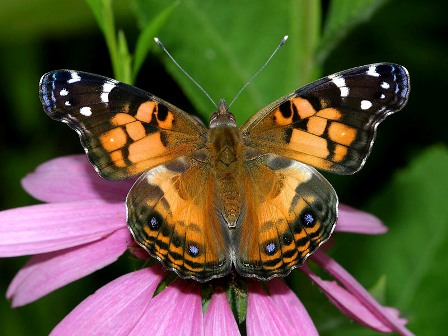American Lady
Vanessa virginiensis
Family: Nymphalidae
Subfamily: Nymphalinae
Identification: Upperside with uneven brown, yellow, and orange pattern. Forewing with a black apical patch, a small white spot in the orange field below the patch, and a white bar at the leading edge of the forewing. Underside of hindwing with two large eyespots. Winter form is smaller and paler, summer form larger with brighter coloring.
Life History: During the afternoon, males perch on hilltops or on low vegetation if there are no hills. Females lay eggs singly on the top of host plant leaves. Caterpillars are solitary, living and feeding in a nest of leaves tied with silk. Adults hibernate.
Wing Span: 1 3/4 - 2 5/8 inches (4.5 - 6.7 cm).
Caterpillar Hosts: Plants in the sunflower family everlasting (Gnaphalium obtusifolium), pearly everlasting (Anaphalis margaritacea), plantain-leaved pussy toes (Antennaria plantaginifolia), wormwood (Artemisia), ironweed (Vernonia), and burdock (Arctium).
Adult Food: Flower nectar almost exclusively, including dogbane, aster, goldenrod, marigold, selfheal, common milkweed, and vetch.
Habitat: Open places with low vegetation including dunes, meadows, parks, vacant lots, forest edges.
Range: Resident in the southern United States, Mexico, and Central America south to Colombia. Migrates to and temporarily colonizes the northern United States, southern Canada, the West Indies, and Europe. Rare stray to Newfoundland and Labrador.




